Sovereign Alchemy Will Fail |
| Egon von Greyerz |
| Matterhorn AM |
When we look at the world economy today, wherever we turn
we see a wall of risk. And sadly this is an insurmountable wall with
risks that are totally unprecedented in history. There has never before
been a potentially catastrophic combination of so many virtually
bankrupt major sovereign states (US, UK, Spain, Italy Greece, Japan and
many more) and a financial system which is bankrupt but is temporarily
kept alive with phoney valuations and unlimited money printing. But
governments will soon realise that they are not alchemists who can turn
printed paper into gold. The consequences of the global financial
crisis are potentially catastrophic.
As the Austrian economist von Mises said: “There is no means of
avoiding the final collapse of a boom brought about by credit
expansion. The alternative is only whether the crisis should come
sooner as the result of a voluntary abandonment of further credit
expansion or later as a final and total catastrophe of the currency
involved.”
In our view, governments like the US and the UK and many
others will not abandon further credit expansion. They are committed to
printing increasing amounts of worthless paper money in order to
finance the growing deficits and the rotten financial system. Therefore there is no
chance of Quantitative Easing ending but instead it will accelerate in
2010 and after. The consequence of this will be a
hyperinflationary depression in many countries due to many currencies
becoming worthless. No economy in the world, including China, will
avoid this severe economic downturn which is likely to have a major
impact on the world economy for many, many years to come.
Investors are ignoring the risks
What makes the current situation in the world economy so
intriguing is that most investment markets have not recognised the
risk. Stockmarkets and bond markets rallied substantially in 2009,
totally oblivious of the risks. The housing market is down in the US
and some European countries like Spain and Ireland. But in many other
countries it is still near the bubble highs created by low interest
rates and reckless lending.
The most important criterion, when taking investment
decisions, is understanding the risks involved. Matterhorn Asset
Management has in the last few years warned investors about the risks
in the financial system due to the massive worldwide credit expansion
and money printing. We have found it difficult to fathom so few people
realise that the world economy has become a time bomb waiting to
explode or more likely implode. All the so called experts have declared
that it is impossible to identify the problems in the financial system
in advance. For example, Greenspan, Bernanke, Geithner, other central
bankers and government officials as well as Blankfein of Goldman Sachs
and many bank heads have all stated that they couldn’t see it coming.
Either they are lying or they are stupid. Sadly, it is most likely the
former. It is virtually impossible to find an honest politician. They
have one major objective – Power. To attain power they have to buy
votes. But to buy votes they cannot tell the truth. No politician ever
forecasts bad news because bad news does not buy votes. (Yes, there are
exceptions like Ron Paul in the US). And as regards the bankers, it is
definitely not in their interest to worry about risks to the financial
system. For every year that they issue additional toxic debt and
derivatives they earn more in that single year than most normal people
earn in a lifetime.
Sovereign Defaults
The list of countries at risk of bankruptcy is increasing
by the day. The acronym used to be PIGS (Portugal, Ireland, Greece and
Spain). It is now PIIGSJUKUS and growing. The main contenders are
currently: USA,
UK, Japan, Spain, Italy, Greece, Ireland, France, Portugal, Baltic
States, Eastern Europe and many more. On a proper
accounting basis all of these countries are already bankrupt, but since
many nations can either print money like the US and the UK or increase
their already high borrowings, like Greece or the Baltic States, they
have technically avoided bankruptcy although in reality all the
countries in the list above are basket cases with very little chance of
a return to normality. Shown below is what we call the Sovereign Time
Bomb. The bomb consists of countries that have a combination of budget
deficit and borrowings relative to GDP which puts them into the
category “Time Bomb” or high risk of default. These countries have
budget deficits from 6% (Italy) to 12.5% (UK, Greece) of GDP and their
Public Sector Debts are ranging from 60% (Spain) to almost 200% (Japan)
of GDP.
The Sovereign Time Bomb
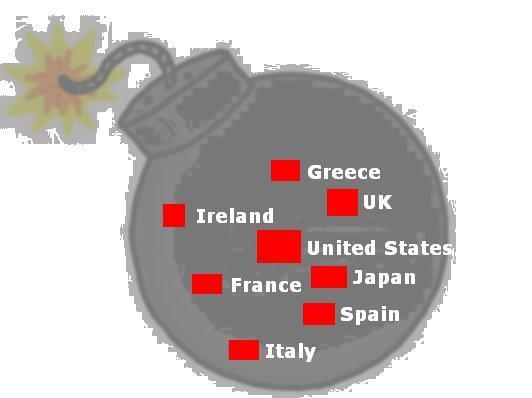
The problem is not just the current debt levels of these
nations, because the deficits in all the countries are rising. Tax
revenues are collapsing and with rapidly rising unemployment, the
governments’ expenses for social charges are soaring. In the US for
example the federal deficit in 2009 was $1.5 trillion (10.7% of GDP)
and is forecast to stay around that level for many years. The plight of
the US states is just as bad. Out of 50 states only 4 are expected to
have a balanced budget in 2010. Up to 40 states, including California,
New York, Florida, Illinois, Michigan, Ohio, North Carolina and New
Jersey, are virtually bankrupt.
It took almost 200 years for US Federal debt to reach $ 1
trillion which it did in 1981. In 2009 the debt increased by $ 1.9
trillion in just that year to $ 12.4 trillion. In the next ten years
the US debt is forecast to reach $ 25 trillion. And this doubling of
the debt does not include any funds to prop up a bankrupt financial
system or the spending of tens or maybe hundreds of trillions of
dollars on worthless OTC derivatives. The forecast also assumes growth
in GDP which is extremely unlikely especially for the next 2-5 years.
Currently US Federal debt is six times what it collects in tax revenue
every year. With debt exploding and tax revenues collapsing, there is
no chance that the debt can ever be repaid with normal money. Also,
with debt out of control interest rates will rise substantially to
10-20% per annum. Applying a 15% interest rate to a $ 25 trillion debt
would give an annual interest bill of $ 3.75 trillion which would be
substantially more than tax revenues.
The chart below shows the US Federal Debt per person. In
the last ten years it has gone from $ 20,000 to $ 40,000. Total US debt, including
private and corporate debt as well as unfunded liabilities, comes to
$430,000 per individual. It is an absolute certainty that every man,
woman and child in the US cannot pay off almost half a million dollars
with normal money. Only massive money printing will take care of that.
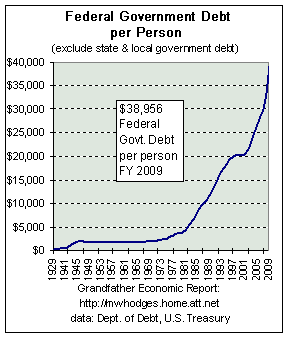
With these levels of deficits for the next ten years on
top of an already massive debt, there is no possibility whatsoever that
the US economy can avoid bankruptcy. No country has ever abolished
debts of this magnitude by printing paper and the US will not be the
first one to succeed either.
Only Lose – Lose Options
Governments have two choices – continue to borrow and
print money or reduce government spending. This is a lose – lose
situation and whatever choice they make it will end in disaster.
Countries within the EMU like Greece or Spain are introducing austerity
programmes that forecast their deficits to come down to 3% of GDP which
is the EU maximum deficit limit. These are totally unrealistic targets
that are mainly based on an improvement in the economy which is total
fantasy. The dilemma is that not one single country within the EU is
below the 3% limit, not even Germany. And the effect of the austerity
programmes will lead to such a major contraction of the economies that
tax revenues will collapse, further exacerbating the plight of these
countries.
The alternative is to print or borrow more money.
Printing is not a luxury that individual EMU members have and for these
insolvent countries to borrow money is becoming almost impossible or
very costly. But the European Central Bank can print money and this is
likely to be the path they will initially choose to save Greece and
possibly Spain. Countries like the US and the UK can still borrow and
print money. And this is what they will continue to do. With rising
deficits, rising unemployment and the problems in the financial system
re-emerging they have no choice. Both the UK and the US are set upon a
course of self-destruction. We will see trillions of pounds and dollars
printed in the next few years. But the only buyers of these government
securities will be the US and UK governments. The rest of the world
will dump their holdings which will result in both the dollar and the
pound dropping precipitously and interest rates rising substantially.
Hyperinflation – Consequences
The effect of a collapsing currency will be a
hyperinflationary depression. This is the inevitable outcome for the UK
and US and there is sadly no action that the governments of these
countries can take to alter this course. We discussed the consequences
of this outcome in our July 09 newsletter – “The Dark Years Are Here”.
There will be extreme poverty. None of the social safety nets will
function. So most of the social security payments that people in need
have been used to will disappear or be worthless due to hyperinflation.
There will be severe shortages of food which will lead to famine and
social unrest. Hungry people are restless people that will take the law
into their own hands. This will lead to violent protests, lawlessness,
theft and violent crime. And there is unlikely to be a force of law
that is paid and functional to deal with the problems. Already today,
many US cities and states are cutting down on the police force and
their equipment. This trend will accelerate during 2010 due to budget
cuts and lack of funds.
There will be massive cuts in education and many schools
will close due to lack of resources. Pensioners will be major
sufferers. Many pension plans are unfunded but also the funded ones
will be decimated. Pension funds are invested in three areas –
equities, bonds and real estate. All three are likely to go down by at
least 50% but probably more like 75% at least, all in real terms.
Deflation and Inflation
Most economists and financial analysts disagree with the
hyperinflationary scenario and believe that the deleveraging of debt
will lead to a deflationary downturn. That scenario would be more
likely if countries like the US and UK were not printing endless
amounts of fiat money. As we have explained above the printing presses
will not slow down but they will accelerate in coming years. The UK’s
announcement that they will cease Quantitative Easing is just a
temporary measure that won’t last. Governments detest
deflation because they know that deflation after uncontrolled credit
growth would lead to an implosion of the financial system and the
economy. Virtually all bank loans and OTC derivatives have been issued
against inflated and unsustainable asset values. In a deflationary
economy with falling asset values, falling wages, falling corporate
profits and falling government revenues, there is no possibility that
the massive amount of bank credit outstanding can be serviced or
repaid. Therefore the banking system would not survive due to their
massively inflated balance sheets and low equity. This is why
governments are petrified of deflation after a sustained period of
asset and credit bubbles. So their only option is to print whatever
money is required to stave off deflation. And this is what they will
do. There is absolutely no doubt about it. But they are doing
this in total ignorance of the consequences.
Governments created the financial crisis
The current financial crisis was not created by the
banks. It was created by governments’ irresponsible policies of buying
votes by manipulating the financial system through constant money
printing, especially since the creation of the Fed in 1913 and the
abolition of the gold standard in 1971. In addition they have used
interest policy as a popularity contest thereby creating a totally
artificial market which distorts the normal laws of supply and demand.
It is clearly ludicrous to artificially keep interest rates at 0% and
print massive amounts of money. Neither governments, nor banks
should be allowed to create money out of thin air or interfere with
market forces by artificially setting interest rates. It is this
corrupt manipulation of the financial system and the economy that has
totally destroyed the value of money in the last 100 years. Measured
against gold, the dollar and the pound have declined by 99% since 1913.
This would not have happened if governments had not been allowed to use
the financial system as a voting machine. But sadly this will continue
at an accelerated pace in the next few years. Governments seem totally
incapable of comprehending that they cannot solve the world’s greatest
financial crisis by applying more of the same toxic medicine that
created the problem in the first place.
The prosperity illusion
When you live in the midst of history you don’t realise
that you are part of making extraordinary history. Therefore most
people don’t understand that the last 100 years has been an
extraordinary period in history and even more so the last 20-30 years.
The perceived prosperity and increase in living standards have been
achieved primarily through massive increases in borrowing, both by
governments and by individuals. Take away the enormous debt that has
been created during this period and the world would be a lot poorer.
Alternatively, apply a market rate of interest on the debt. If
governments had not manipulated interest rates and set them at
artificially low levels, the normal forces of supply and demand would
have forced rates considerably higher, most probably in double digits.
The higher rates would have reduced demand for credit and thereby
prevented the credit and asset bubbles that have caused the worldwide
financial crisis. In recent years, Greenspan reduced rates from
6% to 1% between the end of 2000 and 2003. And Bernanke again applied
the only remedy that central bankers know, in addition to printing
money, when he reduced rates from 5% to 0% between 2007 and 2008.
These people seem incapable of understanding that simple laws of supply
and demand would have repaired the economy automatically without their
incompetent and desperate interventions. By leaving monetary policy to
market forces we would have normal recessions and minor booms that
would be totally self-regulating. What the central bankers instead have
created is the most enormous bubble in world history. And sadly like
all bubbles, this one can only end in a disaster of a magnitude that
will affect the world for a very, very long time.
So the last 100 years will be seen in history as an
extraordinary period when governments thought that they had invented a
new economic miracle based on unlimited credit and money printing. But
sadly this miracle will be seen by future historians as another failed
delusional economic theory dreamed up by politicians.
Risk of systemic failure of the financial system
The current financial crisis started due to the
uncontrolled, worldwide debt and asset bubbles. The subprime defaults
were just the first symptom of the lethal concoction of credit and OTC
derivatives that the bankers had constructed for their own personal
gain with no understanding of the risks or the consequences.
Governments and central banks worldwide injected or guaranteed around
$20 trillion just to save the financial system. But the only people who
have benefited from this are the people who caused it. Very little of
these enormous sums went into the real economy. In addition to this
enormous liquidity for the benefit of the banking system, governments
have allowed banks to value their assets at totally false prices not
based on market values but on the hope that they will achieve full
value at maturity. To further assist the banks governments worldwide
have reduced interest rates to zero percent. So with trillions in fresh
liquidity, zero interest rates and valuing assets at fantasy prices,
many banks have produced record profits and paid record bonuses.
Money supply in the US as measured by M3 is collapsing.
The chart below shows how M3 has declined almost 6% year on year. This
particular indicator has been very accurate in forecasting the major
economic downturns in the last 40 years and is now at the same level as
before the 1970s recession.
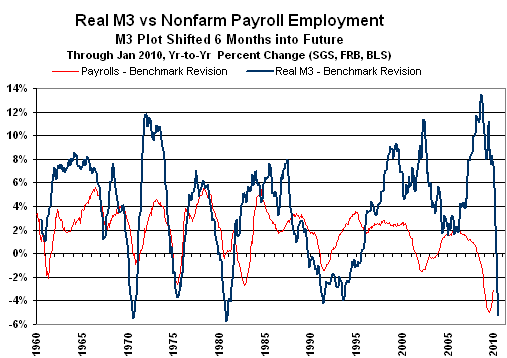
None of the problems that caused the banking crisis in
2007-8 have been solved. They have just been swept under the carpet. In
the US 140 banks failed in 2009 against 25 in 2008 and only 11 banks in
the five preceding years. So far in 2010 a total of 15 banks have
failed and been taken over by the FDIC (Federal Deposit Insurance
Corporation). Virtually all the banks that fail show losses that are
far greater than the balance sheet valuations. Of the circa 6,000 US
banks, a major percentage will fail in the next few years due to
rapidly declining asset values. This will also be the case for many of
the major international banks. If their assets, and in particular their
OTC derivatives were valued at market, very few banks would be solvent
today. In addition, resets of mortgage loans, commercial real estate
loans, credit card loans, private equity loans etc are all problem
areas that could bring major banks down.
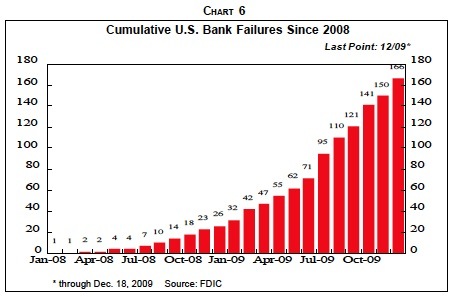
The risk of terrorism
Terrorism is an imponderable and it is therefore
impossible to forecast where or when it could happen. With 700 US bases
in 120 countries and with the US, UK and other countries’ involvement
in Iraq and Afghanistan, the alienation that this creates especially in
the Muslim world, poses a major threat of terrorist attacks especially
in the US and UK. The terrorists are almost always ahead of the
intelligence agencies and security services. Therefore it is impossible
to forecast how, where or when the next attack will happen. It could be
planes, it could be shopping centres, or it could be a cyber war
against major international computer networks. The more troops that the
UK and US send to Afghanistan the higher the risks of terrorist acts
against them. The greatest likelihood of preventing or reducing
terrorism would be for the US and the UK to close all foreign military
bases and to withdraw all troops. Sadly, that is a very remote
possibility.
Markets
In January 2009 we forecast that stockmarkets were likely
to correct up to 50% of the down move before continuing the bear
market. The Dow Jones corrected just over 50% but it took a bit longer
than we expected. The correction is now finished and the primary trend
of all stockmarkets is now resuming its downtrend. We are expecting
very substantial falls during 2010. This will not be a year to be
invested in general equities. We expect precious metal shares to do
very well even though initially they will come down with the market.
Bonds
One year ago we predicted that US long bond rates would
rise. This is exactly what happened and the 30 year Treasury Bond yield
went from 2.5% to 4.6% during the year. We expect US and UK bond rates
to continue to rise in 2010. This will be as a result of foreign
holders selling their holdings of these bonds due to the dire economic
situation in the US and UK and the currencies weakening. International
investors are not prepared to finance bankrupt sovereign states without
getting ample reward for the risk.
Currencies
Most people judge currencies on a relative basis. This is
a very poor measure of the value of a currency since it doesn’t take
into account the total destruction of paper money in the last 100
years. We showed in our December report (“Gold is not going up – Paper
Money is going down”) that most major currencies including the dollar,
pound, Dmark/Euro and Yen have all declined 99% against real money –
gold – since the creation of the Fed in 1913. Thus, all currencies are
weak and they will continue to be attacked one at a time. Fundamentally
the dollar is the weakest currency and we would expect the next leg
down to start relatively soon.
The Euro also has its problems and is suffering from the
problems of its weakest members – Greece, Spain, Portugal, Italy, and
Ireland. Like all artificial currencies the Euro was doomed to have a
relatively short life in its original form. We predicted this long
before its birth in Maastricht in 1992. Short term the European
Central Bank will support Greece and all other EU nations that need
support. Longer term, once too much worthless money has been printed by
the ECB without solving the problems, the European Monetary Union is
likely to break up.
But the current fear over Euroland and the weakness of
the Euro relative to the dollar is overdone. The Euro zone budget
deficit to GDP is 6.7% and debt to GDP is 88% whilst the US deficit is
10.7% and debt 92%. So on this basis it is extremely unwise to shift
funds out of the Euro and into US dollars especially since the
underlying fundamental problems are much greater in the US.
All the countries of the major trading currencies – the
Dollar, Euro, Pound and Yen – have major economic problems that can
only be resolved by massive money printing. This is why it is a futile
game to try to predict which currency will be the weakest out of the
above four. They will all weaken substantially but not at the same
time. Therefore, we will have incredible volatility in currency markets
in the next few years whilst speculators lose their shirts jumping from
one currency to the next. There will be very few winners in that game.
So are there any currencies that are better? Yes,
relatively, the Norwegian kroner, the Canadian dollar and possibly the
Swiss Franc and Australian dollar will do better. The Renminbi will
also do well but is difficult to invest in.
Gold
So whilst many paper currencies become virtually
worthless in the next few years, gold will continue to do what it has
done for 6,000 years. It will maintain its purchasing power and
therefore appreciate substantially against all paper currencies.
The recent correction in gold is the weak hands getting
out of speculative positions in the paper gold market. There has been
virtually no selling in the physical market.
So far gold has gone up more than four times in the last
ten years in a stealth market that very few investors have participated
in. The table below shows the extraordinary return that investors in
gold have achieved in the last 5 and 10 years. There is no other asset
during this period that has given such an excellent return whilst at
the same time providing the highest form of wealth protection (provided
it is physical gold).
Average annual return on over 5 and 10 years
|
Period/Currency |
US Dollar |
Pound |
Euro |
Yen |
Swedish Kr. |
|
2000 – 2005 |
9.7% p.a. |
5.2% p.a. |
2.3% p.a. |
8.8% p.a. |
11.0% p.a. |
|
2005 – 2010 |
20.4% p.a. |
25.0% p.a. |
19.1% p.a. |
19.2% p.a. |
19.4% p.a. |
|
2000 – 2010 |
15.1% p.a. |
15.1% p.a. |
10.7% p.a. |
14.0% p.a. |
15.2% p.a. |
Return last 10 years
Over the last 10 years a US and UK investor would have
made an average return on gold of 15.1% per annum.
Return last 5 years
In the last 5 years until the end of 2009, the lowest
annual return on gold was in Euros with 19.1% per annum and the highest
in Pounds with 25% p.a.
These
are absolutely outstanding returns which most investors are totally
oblivious of.
But
the awareness will change in the next few years as gold rises even
faster.
Many investors, including George Soros, who have missed
the bull market in gold (or the bear market in paper currencies), now
believe that gold is overbought and therefore it is too late to invest.
The next chart disproves that theory totally. The chart shows gold in
2009 dollars adjusted for real inflation. Shadowstats.com is a superb
service which analyses government statistics on a true basis, taking
out all adjustments, revisions and other manipulations. Applying the
true inflation rate on the gold price shows that the gold high in 1980
of $ 850 in today’s terms is $ 6,400.
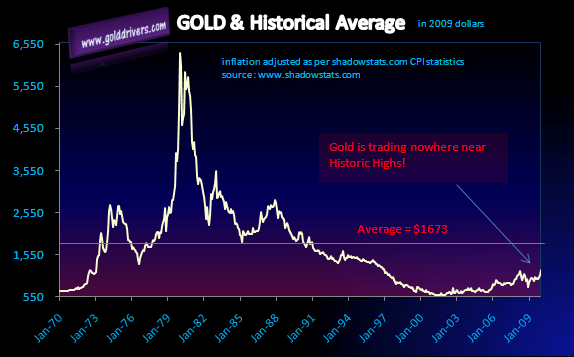
Governments have suppressed the gold price in the last 30
years by both overt operations (official gold sales) and covert
operations (manipulations in the paper gold market and unofficial
sales). Central banks are supposedly holding 30,000 tons of gold but
credible estimates suggest that this figure is around 15,000 which
means that 15,000 tons of central bank gold has been sold covertly to
depress the price. But the effect of manipulation of any market has a
limited time span, especially if it is done in connection with a total
mismanagement of the economy. Central banks have now stopped official
sales and China, India, Russia and many other countries are major
buyers. Production is falling steadily and investment demand is
soaring. With the fundamentals so much in gold’s favour, it should have
no problem to reach the 1980 inflation adjusted high of $ 6,400. With
inflation or hyperinflation gold will go a lot higher than that.
During the next phase up in gold which we expect to start
within the next few weeks, main stream investors will discover what
only a few investors have understood in the last ten years, namely that
physical gold is one of the very few ways to protect their assets and
preserve capital.
Egon von Greyerz
Mattherhorn Asset Management
AG
Matterhorn Asset Management has set up a separate Gold
Division called GoldSwitzerland (www.goldswitzerland.com) in
order for investors to purchase physical gold at very competitive
prices and store it in their own name in Zurich, Switzerland outside
the banking system and with personal access to their own gold bars.